© 2025 MJH Life Sciences™ , Patient Care Online – Primary Care News and Clinical Resources. All rights reserved.
Flu in Adults with Chronic Health Conditions
When it comes to flu vaccination, nearly 50% of US adults don’t know the benefits. Are your patients among them?
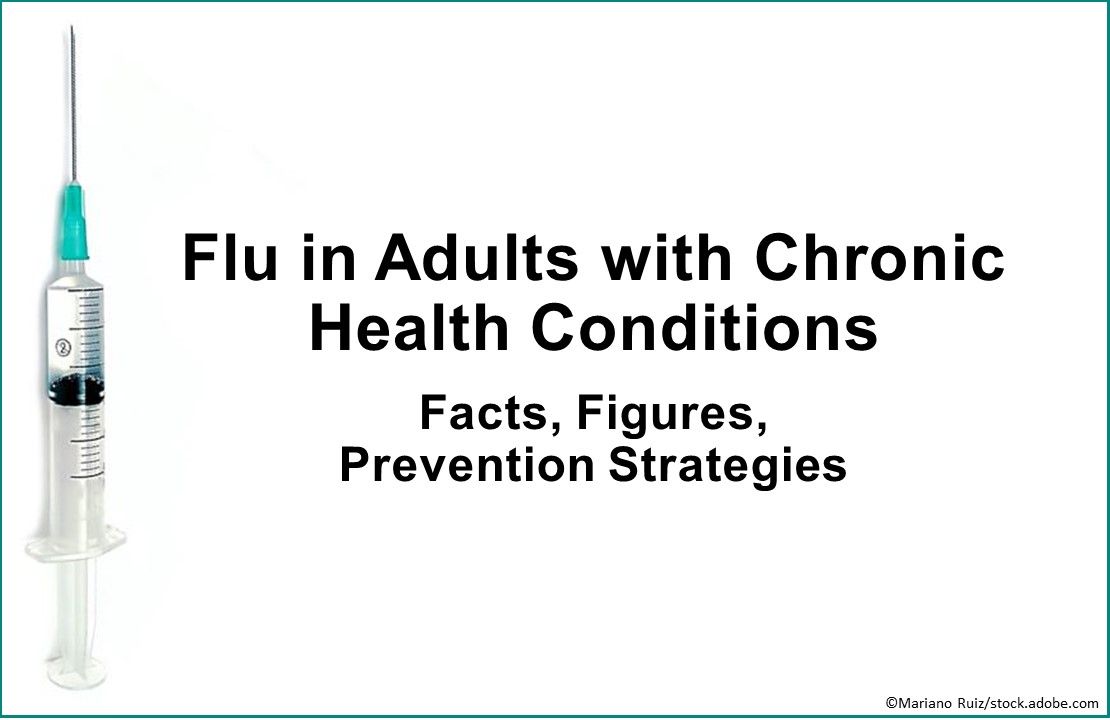
As flu season approaches, adults with chronic health conditions are at particular risk for infection and for dangerous complications. In a recent publication the National Foundation for Infectious Diseases (NFID) highlights vulnerabilities of specific populations, addresses barriers to recommended vaccination among patients and providers, and suggests strategies to help primary care practitioners reach a goal of ≥90% vaccination coverage among patients in the practice.
Scroll through the slides above to find concise summaries of key facts, figures, and prevention strategies included in the NFID's Call to Action: The Dangers of Influenza and Benefits of Vaccination in Adults With Chronic Health Conditions.

Chronic conditions raise risk. Nearly half of US adults aged 45-64 years have ≥2 chronic health conditions (eg, heart disease, lung disease, and diabetes). An estimated 31% of those aged 50-64 years and 47% of those aged ≥65 years are at high risk for flu-related complications or are likely to have decreased vaccination response. Among adults hospitalized for flu, 92% had at least 1 reported underlying medical condition that placed them at high risk for flu-related complications. Most commonly reported underlying conditions were cardiovascular disease (46%), metabolic disorders (43%), obesity (37%), and chronic lung disease (30%).

Older adults with flu face serious consequences. Flu season has a disproportionate effect on adults aged ≥50 years who have chronic health conditions. In one study, hospitalized adults aged ≥65 years with laboratory-confirmed flu were more likely to experience persistent catastrophic disability. Older adults account for 90% of flu-related deaths and most flu-related hospitalizations. Frailty as a measure of health and functioning may be more accurate than chronological age for predicting poor flu-related outcomes.
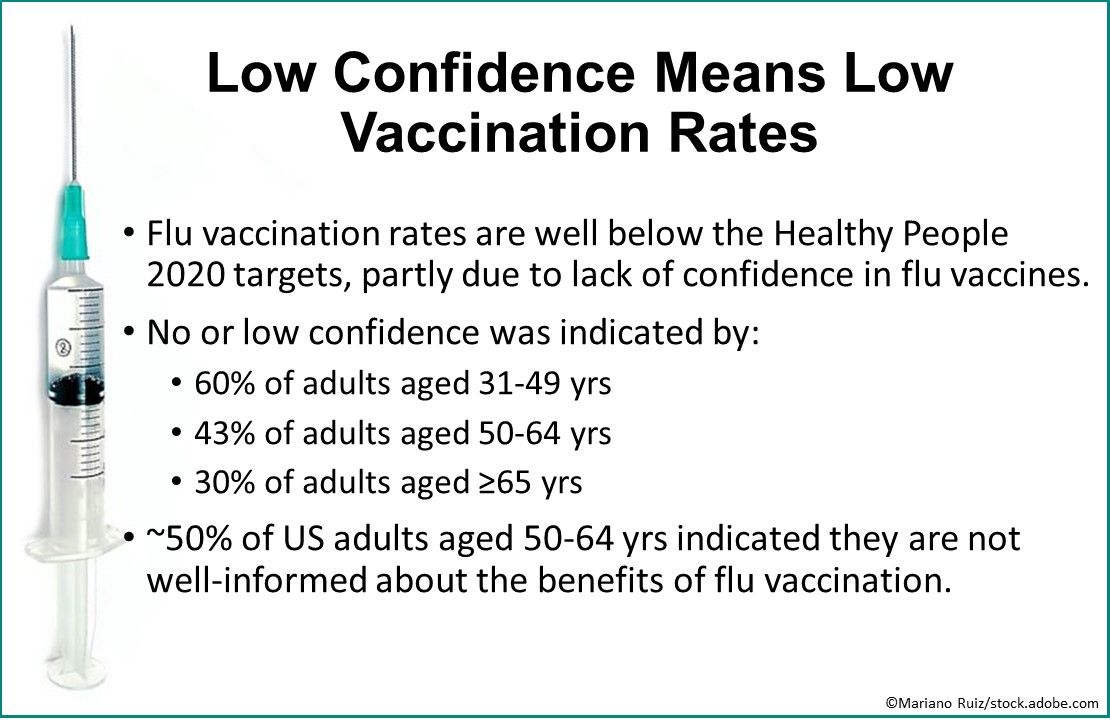
Low confidence, low vaccination rates. In spite of increased risks and consequences in older adults with chronic health conditions, flu vaccination rates are well below the Healthy People 2020 targets-80% for adults aged 18-64 years and 90% for adults with high-risk conditions, including those aged ≥65 years-partly because of a lack of confidence in flu vaccines. In one study, no or low confidence was indicated by 43% of adults aged 50-64 years, 30% of those aged ≥65 years, and 60% of those aged 31-49 years. Misperceptions about the flu are a major reason for lack of confidence with ~50% of US adults aged 50-64 years indicating they are not well-informed about the benefits of flu vaccination.
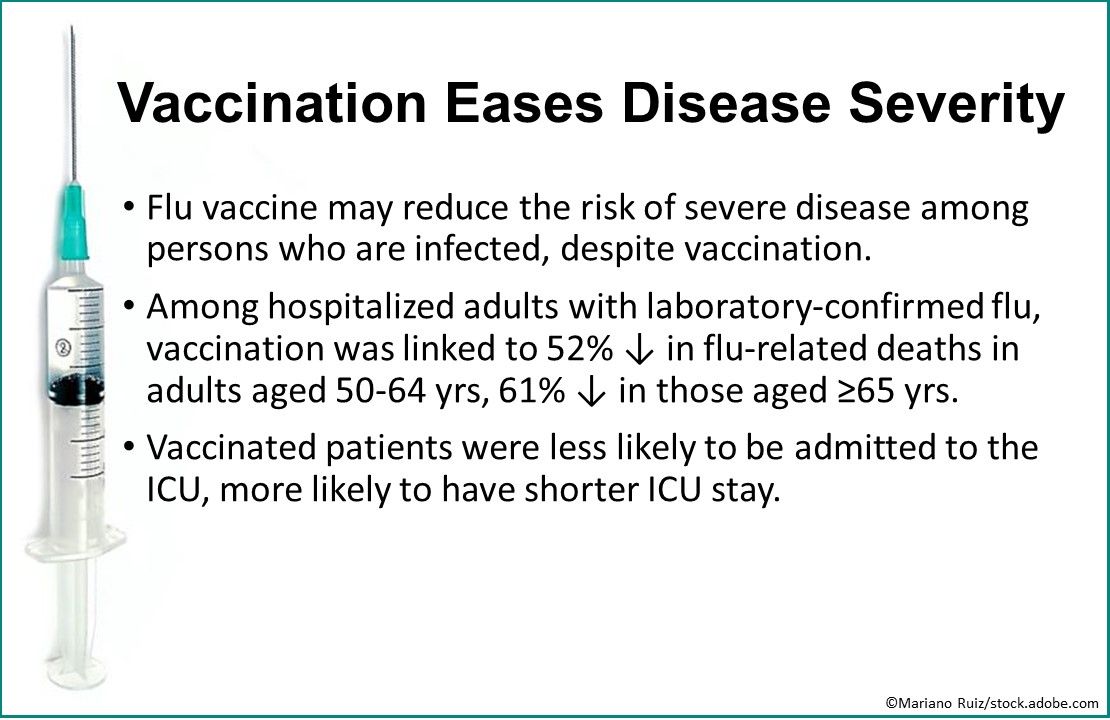
Vaccination mitigates disease severity. Flu vaccine may reduce the risk of severe disease among persons who are infected in spite of being vaccinated. In a study of adults hospitalized with laboratory-confirmed flu, vaccination was associated with a 52% and 61% decrease in flu-related deaths in those aged 50-64 years and those aged ≥65 years, respectively, vs similar-aged unvaccinated patients. Furthermore, vaccinated patients were less likely to be admitted to the ICU, and the length of ICU stay was shorter.
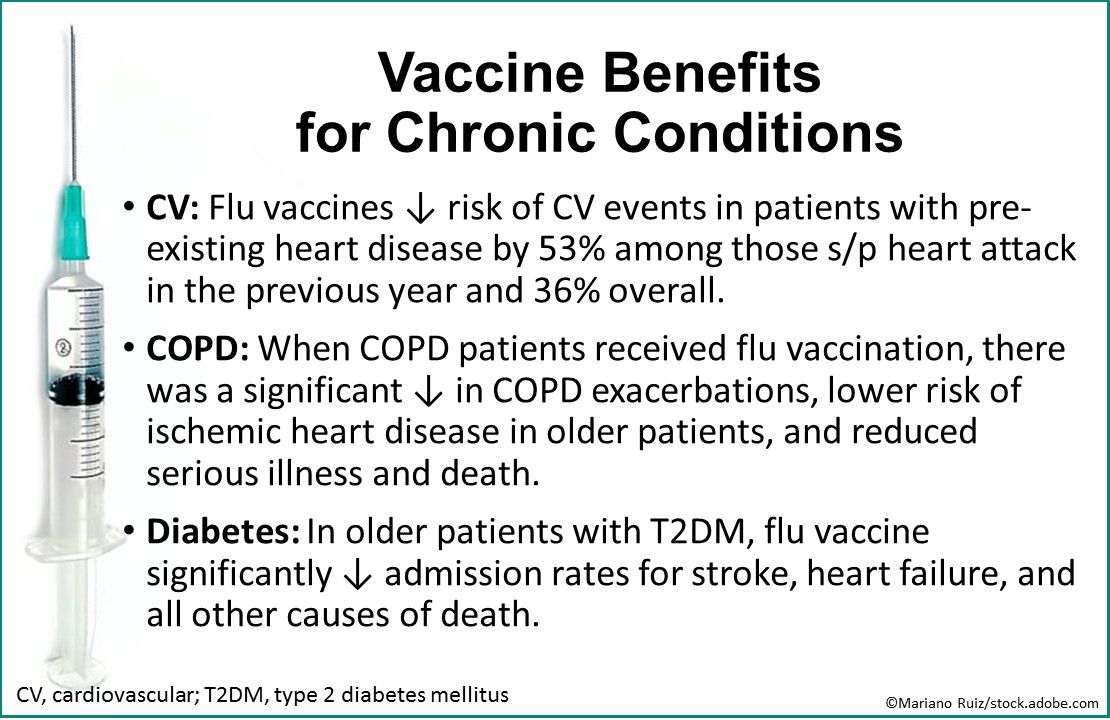
CV, COPD, and diabetes benefit with vaccination. In a recent study, flu vaccines reduced the risk of CV events in patients with pre-existing heart disease by 53% among those who had a heart attack in the previous year and 36% overall; the vaccine also reduced mortality risk by 19% among all study patients. Among COPD patients, the flu vaccine resulted in a significant drop in COPD exacerbations, a lower risk of ischemic heart disease in older patients, and reduced serious illness and death. In older patients with T2DM, flu vaccine significantly reduced admission rates for stroke, heart failure, and all other causes of death.
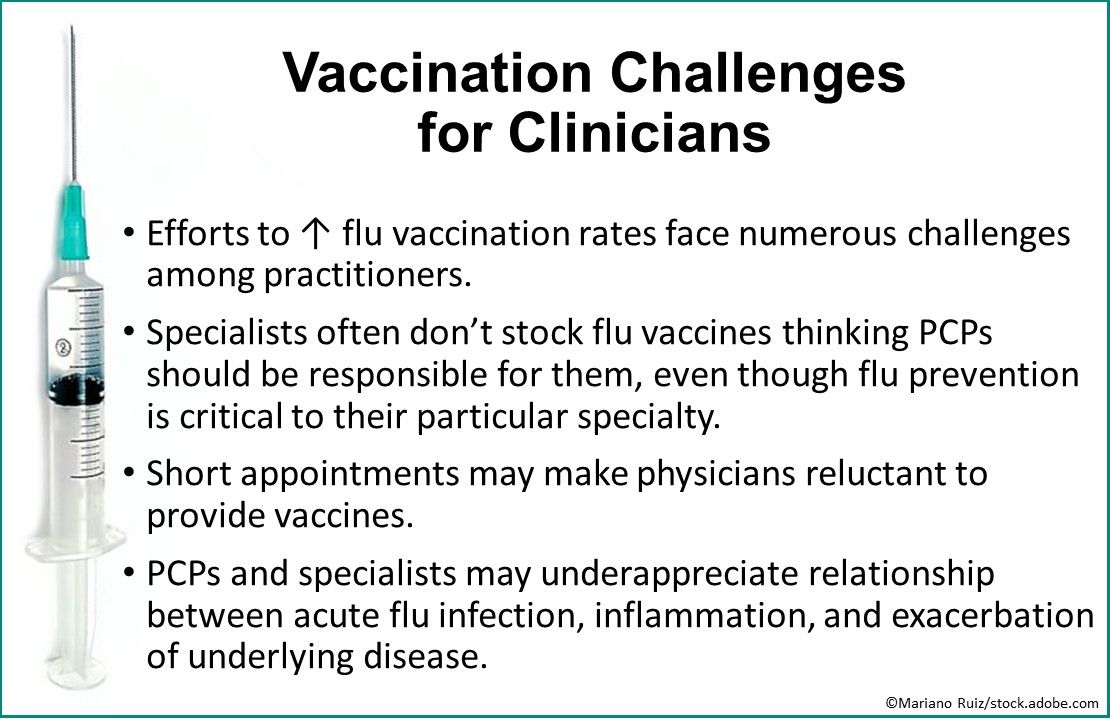
Flu vaccination challenges among clinicians. Efforts to increase flu vaccination rates face numerous challenges among practitioners. Many specialists do not routinely stock flu vaccines because they think PCPs should be responsible for them, even though flu prevention is important to their particular specialty. Time with patients is limited-especially with predetermined time limits for patients who have multiple chronic conditions-so physicians may be reluctant to provide vaccines. And both PCPs and specialists may underappreciate the relationship between acute flu infection, inflammation, and exacerbation of a patient’s underlying disease.
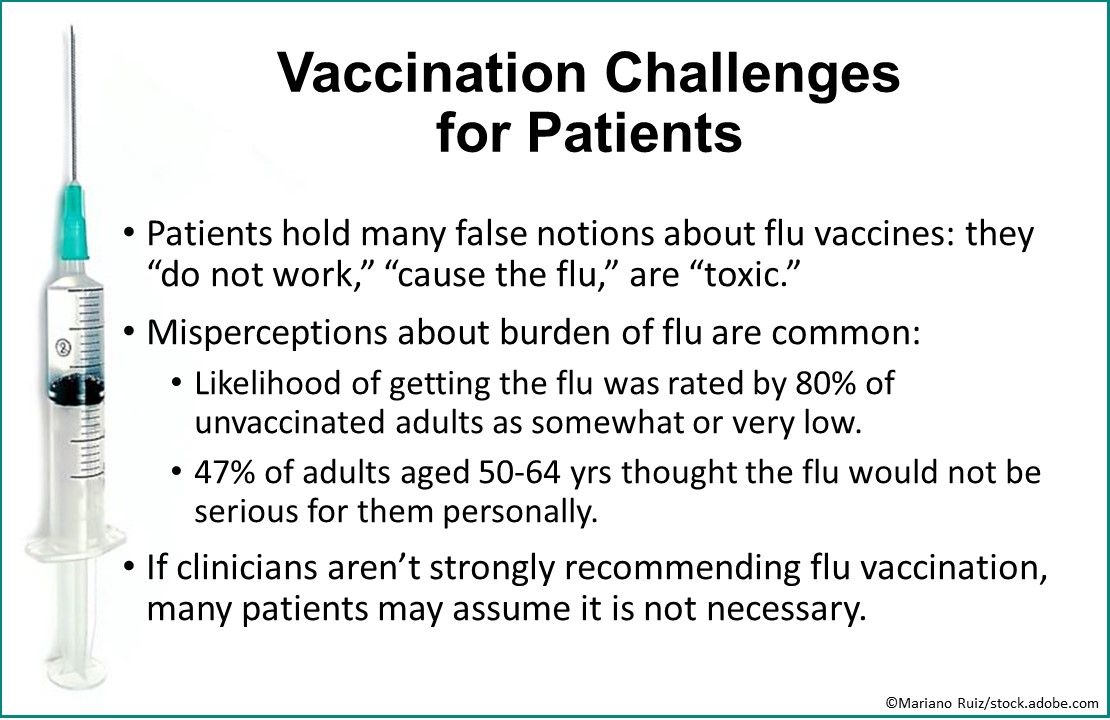
Flu vaccination challenges among patients. False notions about flu vaccines are prevalent among patients, with many thinking they “do not work,” “cause the flu,” or are “toxic.” Misperceptions about the burden of flu are common. For example, the likelihood of getting the flu was rated by 80% of unvaccinated adults as somewhat low or very low. Among adults aged 50-64 years, 47% thought the flu would not be serious for them personally. Fewer than half said they are “less than very well-informed” about the impact of flu and the added burden and risks for adults with chronic health conditions. If practitioners are not strongly recommending flu vaccination, many patients may assume vaccination is not necessary.

Flu vaccination recommendations. To increase flu vaccination rates in adults with chronic conditions, the NFID report offered several recommendations: stock flu vaccine and insist upon annual vaccinations; reach out to patients who do not have a scheduled fall visit and ask them to come in for vaccination; for those who cannot provide flu vaccination onsite, write a “prescription” for flu vaccine to help reinforce the importance of the recommendation; and establish a goal of ≥90% vaccination coverage among patients and assess progress on an ongoing basis. Overall, help reframe the conversation about the value of annual flu vaccination for adults with chronic health conditions and for the community as a whole.
Related Content:



